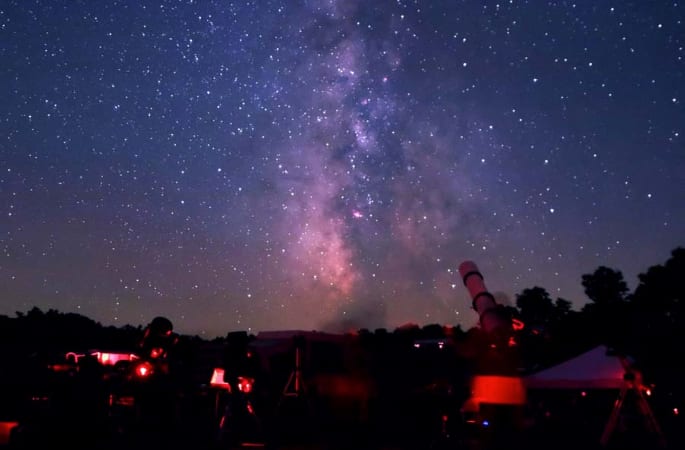by Jennifer Nichols
I was recently asked if GreenWeaver installs outdoor lighting. Any good business person would immediately jump on this opportunity to sell additional services to a client, but I always respond to this question with reservation. As an environmentally responsible landscape company, how do we justify adding services that require electricity, have the potential to damage the night-time ecology, and can even harm human health? The answer is tastefully and responsibly, of course.
Tasteful Lighting
Although tastes vary, there are some general rules that apply when it comes to outdoor lighting.

International Dark Sky Association approved streetlights provide safe nighttime lighting. Photo Jim Richardson.
Less is More
Assuming you do not want your nighttime property to look like it does at high noon, the first step is to determine what you want to illuminate.
According to Jeff Wonsetler at Lightology.com: “What you do not want to do is light up your whole yard like a Las Vegas casino. If everything is highlighted, then nothing stands out and nothing is special. Instead, consider what features you want to show off, and determine how you plan to use specific outdoor areas. Select those few choice features, light them well (in terms of light quality, appropriate beam spread, and fixture placement), and then think about filling in other areas.
Keep in mind that at night, your eyes are already adjusted to the dark. If you keep overall light levels low, then the contrast between light and shadow of a highlighted exterior feature can create a much more dramatic effect.”
Color
Avoid blues which appear unnatural and opt for warmer colors. LED lights initially had a bad reputation for quality of light due to their blue tones, but with recent advances in technology, LEDs now come in much more inviting colors. Choose warm whites for more relaxing and inviting spaces.
Levels
Use different levels of lighting for different purposes. Use low lights for soft mood lighting or path lighting and brighter lights for accents. If everything is lit at the same level, your eye will not know where to focus.
Dimmers and timers are also nice options. Outdoor seating areas can be softly lit during entertaining, and then the light can be turned up during cleanup. And timers can be set to turn the lights off when they are not in use.
Problems with Nighttime Lighting
Until relatively recently, I was unaware of many of the problems associated with nighttime lighting. I had heard the term light pollution as it applies to human activity such as astronomy, or irritating lights shining in bedroom windows at night. There are however, much greater problems associated with light pollution.

Controlling light pollution from nighttime lighting is ecologically beneficial, and also supports events like this star party at Cherry Springs, PA. Photo by Terrence Dickinson.
Nighttime Ecology
When most of us are crawling into bed at night, there is another complex ecology that is just beginning to awaken. Flowers in need of pollination by moths, fireflies searching for each other by using their own illumination, owls whose predatory advantage depends on darkness, and even baby sea turtles searching for their way to the sea all depend upon dark nights.
Studies show that light pollution has harmful effects on nighttime ecology in numerous ways that we are only beginning to understand. For more information please visit http://darksky.org/light-pollution/wildlife/.
Nighttime Lighting and Human Health
According to a report issued by the National Institutes of Health, “The health effects of light pollution have not been as well defined for humans as for wildlife, although a compelling amount of epidemiologic evidence points to a consistent association between exposure to indoor artificial nighttime light and health problems such as breast cancer, says George Brainard, a professor of neurology at Jefferson Medical College, Thomas Jefferson University in Philadelphia.”
Nighttime lighting can disrupt our circadian rhythm which is what keeps us awake during the day and allows us to sleep at night. According to Paolo Sassone-Corsi, chairman of the Pharmacology Department at the University of California, Irvine,“Disruption of the circadian clock is linked to several medical disorders in humans, including depression, insomnia, cardiovascular disease, and cancer….” (http://www.ncbi.nlm.nih.gov/pmc/articles/PMC2627884/)
And according to Bill Blakemore in his article Scientists Say Darkness Benefits Health (abcnews.go.com, May 17) “Scientists have now discovered that only when it’s really dark can your body produce the hormone called melatonin. Melatonin fights diseases, including breast and prostate cancer.”
Lighting to Deter Crime
Many people believe outdoor lighting reduces crime, but statistics are inconclusive in this regard. In some cases lighting may be beneficial, but poor nighttime lighting can actually be dangerous if it causes glare, providing dark shadows in which criminals can hide.
Additionally, nighttime lighting may actually benefit criminals if there is no one watching lit up areas allowing them to case targeted areas and to see what they are doing. Darkness may actually reduce crime in areas such as these.
ABC News’ Blakemore adds, “Police report that such darkness is often safer. That’s partly because neighbors soon learn to alert police if they see any lights on in a building. There’s even less graffiti because it’s usually lighted walls that attract the spray-can vandals, not dark ones.”
Essentially, lighting for safety is not as simple as it seems.
Responsible Lighting
So given all of the problems associated with outdoor lighting, what can we do?
Tips for Responsible Outdoor Lighting
According to the International Dark Sky Association, responsible lighting should:
- Only be on when needed
- Only light the area that needs it
- Be no brighter than necessary
- Minimize blue light emissions
- Be fully shielded (pointing downward)
Celebrate the Night
Of course, we will never eliminate the need for outdoor lighting, nor should we try. Outdoor lighting can be magical. It can set the mood from festive to romantic, celebratory to intimate. It can be welcoming and inviting.
So we at GreenWeaver recommend tasteful and responsible outdoor lighting to celebrate the night. And when the celebration is over, we recommend turning off the lights, so others can enjoy the darkness.
For more information consider:
The End of Night: Searching for Natural Darkness in an Age of Artificial Light by Paul Bogard, Back Bay Books; Reprint edition (July 22, 2014)
International Dark Sky Association at www.darksky.org.
About the Author
 Jennifer Nichols, President of GreenWeaver Landscapes, has been involved in horticulture for over 20 years. She holds a Certificate of Merit in Ornamental Plants and a Certificate of Merit in Landscape Design from Longwood Gardens and is active in continuing education in ecology and landscape design. Jennifer annually volunteers as a Site Coordinator for the Chester-Ridley-Crum Watersheds Association stream clean up. Prior to starting GreenWeaver, she was Vice President of Twin Oaks Landscaping, Inc. of Fairfax, Virginia.
Jennifer Nichols, President of GreenWeaver Landscapes, has been involved in horticulture for over 20 years. She holds a Certificate of Merit in Ornamental Plants and a Certificate of Merit in Landscape Design from Longwood Gardens and is active in continuing education in ecology and landscape design. Jennifer annually volunteers as a Site Coordinator for the Chester-Ridley-Crum Watersheds Association stream clean up. Prior to starting GreenWeaver, she was Vice President of Twin Oaks Landscaping, Inc. of Fairfax, Virginia.
Each author appearing herein retains original copyright. Right to reproduce or disseminate all material herein, including to Columbia University Library’s CAUSEWAY Project, is otherwise reserved by ELA. Please contact ELA for permission to reprint.
Mention of products is not intended to constitute endorsement. Opinions expressed in this newsletter do not necessarily represent those of ELA’s directors, staff, or members.

